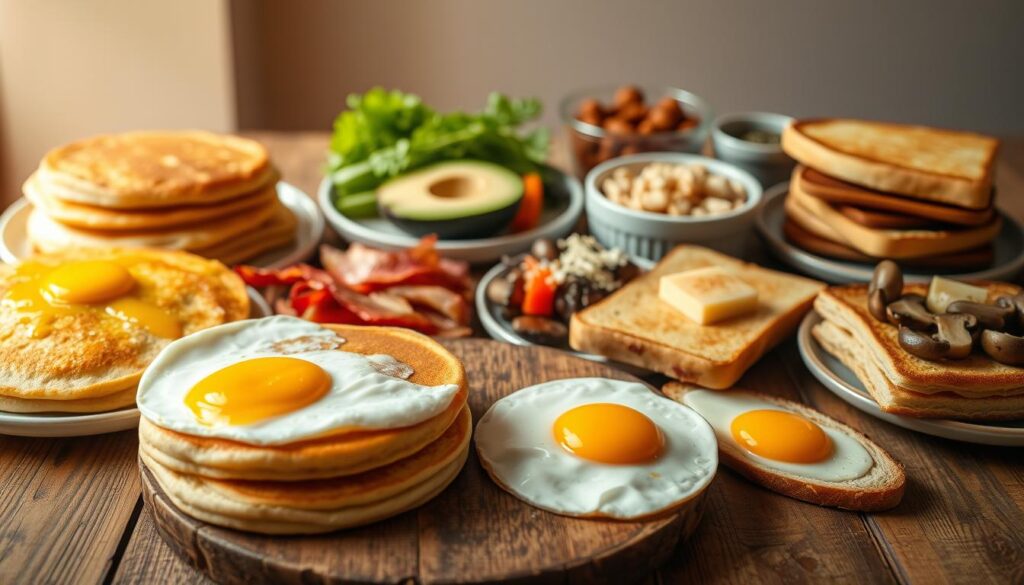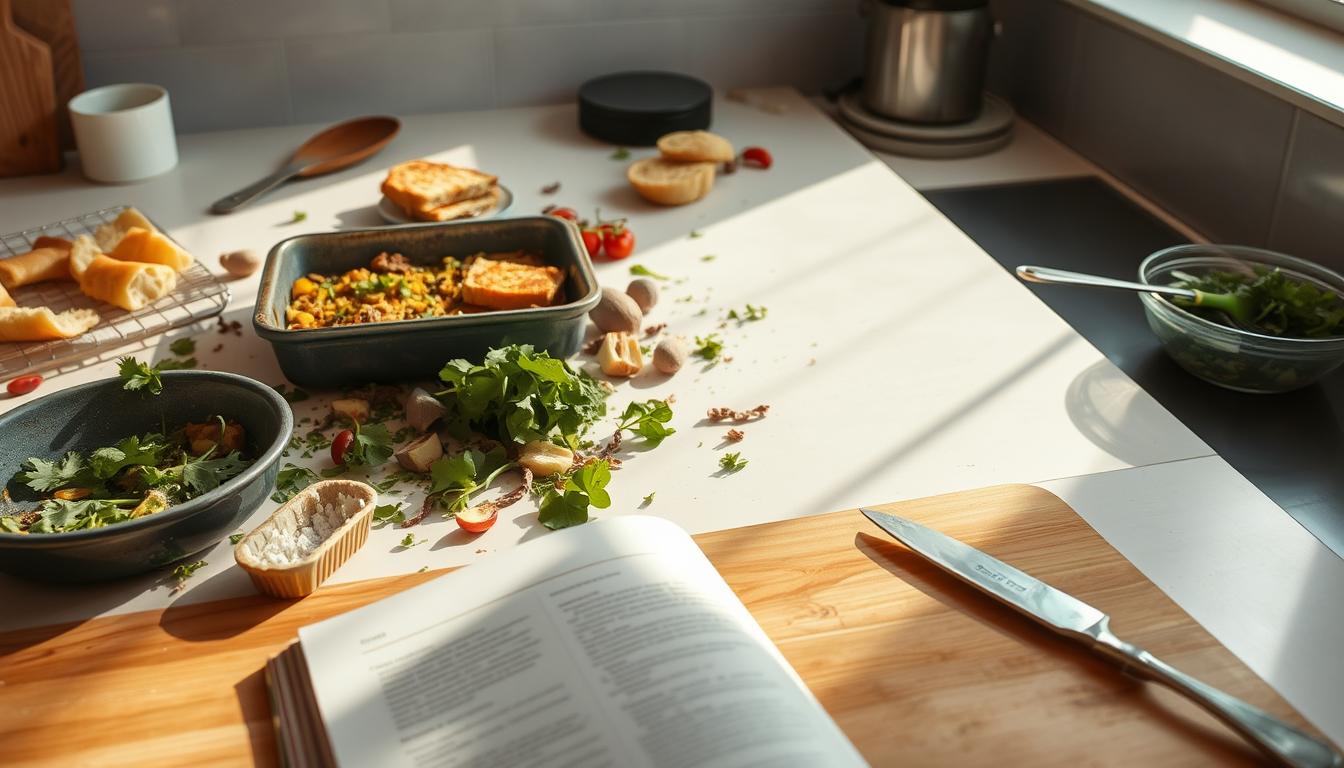We often throw away food that could make a new meal. In the United States, about 40 million tons of food are wasted each year. This could feed around 1 billion people. It shows how important it is to find new ways to use leftovers.
By doing this, we can cut down on waste, save money, and get creative in the kitchen. Using leftover recipes and creative cooking can help us achieve this.
Imagine turning last night’s dinner into a new meal. This reduces waste and helps our planet. It’s a chance to get creative and make delicious new dishes.
By using leftovers, we can make a big difference. The U.S. Environmental Protection Agency says using leftovers is a key way to reduce waste. It helps us save money and create tasty new meals.
Key Takeaways
- We can reduce food waste by finding innovative ways to use leftovers in new dinner dishes.
- Using leftover recipes and creative cooking techniques can help us save money on grocery bills.
- Innovative ways to use leftovers can help us get creative with our cooking and reduce our environmental impact.
- Approximately 40 million tons of food are wasted each year in the United States, which could feed around 1 billion people.
- By using leftovers, we can make a significant impact on reducing food waste and saving money.
- Creative cooking and using leftover recipes can help us achieve our goal of reducing food waste and saving money.
- Innovative ways to use leftovers can help us transform last night’s dinner into a new meal, reducing the amount of food that ends up in landfills.
Understanding the Importance of Using Leftovers
Many of us throw away food that could be used, adding to food waste. Using leftover dinner ideas helps reduce waste. The USDA says the average family throws away $1,500 worth of food each year.
Using leftovers saves money and helps the environment. It encourages us to think creatively and improve our cooking skills. This way, we can make less waste and save on groceries.
Reducing Food Waste and Environmental Impact
Food waste is a big problem in the U.S., making up 30-40% of the food supply. Using leftovers can cut down on waste by up to 50%. Cooking more than you need can save about 20% on groceries.
Saving Money on Grocery Bills
Pre-cooked ingredients can save 20-30 minutes in meal prep. Planning meals and using leftovers saves time and money. It also helps the environment. With a bit of creativity, last night’s dinner can become a new, exciting meal.
Enhancing Creativity in Cooking
Using leftovers boosts our cooking creativity. It challenges us to think of new recipes. Trying different leftover ideas can introduce new flavors and improve our cooking skills.
Transforming Last Night’s Dinner into New Meals
We can turn last night’s dinner into something new by using leftover ingredients. For example, leftover roasted veggies can make a tasty soup or add flavor to a stir-fry. This way of creative cooking cuts down on waste and lets us try out new dinner ideas.
Here are some ideas to reuse leftovers:
- Make a salad with leftover roast lamb for a filling meal
- Use leftover salmon to make a salmon, bacon, and potato hash
- Turn leftover cheese into mac and cheese later in the week
By cooking with leftovers, we can cut down on waste at home. It also helps us save money and be more efficient with resources.
With a bit of creativity, we can make last night’s dinner into something new and good for the planet. By trying out different dinner ideas and creative cooking methods, we can help the environment and save money too.
| Leftover Ingredient | New Meal Idea |
|---|---|
| Leftover chicken | Chicken tetrazzini |
| Leftover beef stew | Vietnamese-inspired sandwiches |
| Leftover challah or brioche | French toast |
Creative Breakfast Ideas with Leftover Ingredients
Leftovers are not just for lunch or dinner. They can also make for tasty breakfasts. Using leftovers for breakfast helps us eat healthier and waste less food. For example, you can make a frittata with leftover veggies or add leftover meats to a burrito.
Popular breakfast ideas include smoothies with leftover fruits and yogurt, and breakfast bowls with leftover grains and nuts. These dishes are not only yummy but also help fight food waste. In the U.S., up to 40% of food goes uneaten.

Using leftovers in breakfast dishes lets us get creative and help the planet. Here are some more ideas:
- Breakfast hashes with leftover meats and veggies
- Omelets with leftover cheeses and herbs
- Breakfast tacos with leftover meats and toppings
These dishes are simple to make and can be tailored to our liking. By using leftovers for breakfast, we save money, reduce waste, and enjoy a nutritious start to our day.
Incorporating Leftovers into Salads and Sides
We can cut down on food waste and spice up our meals by using leftovers in salads and sides. This is a key part of fighting against food waste. For example, we can toss leftover roasted veggies into a salad or use leftover sauce as a dressing. This way, we make the most of what we have and waste less.
Some creative recipes for salads with leftovers include mixing cooked chicken or beans with greens. Leftover grains like brown rice or quinoa can also be used as a base. Adding leftover veggies like carrots, zucchini, or bell peppers adds texture and taste. These salad ideas are tasty and help reduce waste.
- Reduces food waste by up to 25%
- Saves money on grocery bills
- Encourages creative recipes and new ingredient tries
- Supports a more sustainable food system
By taking this approach, we help the environment and enjoy tasty, varied meals. As we look for ways to cut down on food waste, using leftovers in salads and sides is a great step.
| Leftover Ingredient | Salad Idea |
|---|---|
| Cooked chicken | Chicken Caesar salad |
| Leftover grains | Quinoa salad with roasted vegetables |
| Leftover vegetables | Vegetable stir-fry with brown rice |
The Art of Freezing Leftovers for Future Use
Freezing leftovers is a smart way to save food for later. It helps cut down on waste and saves money. By freezing, we can turn last night’s dinner into new meals like soups or casseroles.
There are key tips for freezing leftovers. First, chill the food in the fridge before freezing to avoid ice crystals. Freezing in small portions helps avoid waste. Use regular freezer bags to prevent freezer burn.
Here are some good portion sizes for freezing:
- Cooked beans, rice, or pasta: about 2 cups
- Tomato paste or pesto: freeze in 1-2 tablespoon portions
To thaw safely, put frozen leftovers in the fridge a day before. Most people reheat in the microwave, but it’s safer to thaw first. This way, we can enjoy our leftovers safely and reduce waste.
| Food Item | Freezing Time | Thawing Method |
|---|---|---|
| Cooked Meals | 3-6 months | Refrigerator or Microwave |
| Vegetables | 6-12 months | Refrigerator or Cold Water |
By freezing leftovers, we can save money and reduce waste. It opens up a world of creative cooking. With practice, we can master freezing leftovers and enjoy new meals.
Innovative Dishes Using Leftover Proteins
We can cut down on food waste and make tasty meals by using leftover proteins. This method is good for the planet and saves money. It helps us eat more protein and lower our grocery bills.
For example, we can turn chicken into tacos, make beef stroganoff from roast, or create seafood chowder from fish scraps. These dishes are not only delicious but also help us cook more sustainably.
Transforming Chicken into Tacos
This recipe turns leftover chicken into tacos. It’s a fun and interactive meal. By adding toppings and seasonings, we make a unique and tasty dish that fights food waste.

Beef Stroganoff from Last Night’s Roast
Beef stroganoff made from last night’s roast is another great idea. It shows how leftover proteins can become a new, exciting meal. This supports anti-waste cooking and reduces waste.
| Dish | Leftover Protein | Description |
|---|---|---|
| Tacos | Chicken | Transforming leftover chicken into tacos |
| Beef Stroganoff | Beef | Making beef stroganoff from last night’s roast |
| Seafood Chowder | Fish | Creating seafood chowder from fish scraps |
Utilizing Grains and Pasta Leftovers
We can cut down on food waste and spice up our meals by using leftover grains and pasta. We can make tasty fried rice, pasta bakes, and grain bowls with a twist. These leftover recipes add variety to our daily meals, showing how versatile grain dishes are in creative cooking.
Some ideas for using leftover grains and pasta include:
- Making fried rice with leftover rice and vegetables
- Creating a pasta bake with leftover pasta, sauce, and cheese
- Building a grain bowl with leftover grains, vegetables, and a protein source
These dishes can be made with many ingredients and tailored to our tastes and diets.
Using leftover grains and pasta helps us save money and reduce waste. On average, a household can save $1,500 a year by using leftovers wisely. It also helps the environment by reducing food waste, making it a greener choice for our meals.
| Leftover Ingredient | Storage Time | Usage Ideas |
|---|---|---|
| Leftover Rice | 2-3 days in the fridge, frozen for longer freshness | Fried rice, stuffed peppers, soups |
| Leftover Pasta | 3-5 days in the fridge | Pasta bakes, salads, soups |
Snack and Appetizer Ideas for Leftovers
We can cut down on food waste by turning leftovers into tasty snacks and appetizers. This method not only reduces waste but also makes our meals more interesting. By adopting anti-food waste practices, we can whip up tasty and creative dishes.
For snack ideas, try using leftover veggies to make stuffed veggies. Or, turn last night’s dinner into cool dips and spreads. These snacks are not just yummy but also help fight food waste. Studies show that about 30% of food in the U.S. goes to waste. Using leftovers in our snacks and appetizers can help lessen this problem.
Here are some ideas for snack and appetizer ideas using leftovers:
- Transform leftover party food into creative crostinis
- Use leftover vegetables to make stuffed vegetables
- Create refreshing dips and spreads from leftover sauces and ingredients
By adding leftovers to our snack and appetizer ideas, we can lessen our environmental footprint. We also get to enjoy unique and delicious dishes. This approach encourages us to think creatively and saves us money by reducing grocery bills.
Tips for Creative Leftover Management in Our Kitchens
Learning to manage leftovers is key to cutting down on food waste. By planning meals well, organizing leftovers, and getting our families involved, we can turn leftovers into tasty meals. This way, we make the most of what we have.
Planning Meals Efficiently
Good meal planning is the first step to less waste. Making a weekly menu and shopping list helps us buy only what we need. Using creative cooking to reuse leftovers saves money and reduces waste.
Organizing Leftovers for Easy Access
Storing leftovers right is essential to using them up. Label and date containers, keep them in sight, and have a “leftover night.” This makes it easy to use leftovers in our meals.
Engaging Family in Leftover Meal Prep
Getting our families involved in meal planning and prep helps fight food waste. Asking for their ideas on using leftovers can lead to fun cooking and closer family ties.

